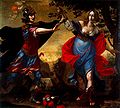art.wikisort.org - Artist
Cesare Dandini (1 October 1596– 7 February 1657) was an Italian painter of the Baroque period, active mainly in his native city of Florence.
Cesare Dandini | |
|---|---|
 Self-Portrait | |
| Born | October 1, 1596 Florence |
| Died | February 7, 1657 |
| Nationality | Italian |
| Known for | Painting |
| Movement | Baroque |
| Wikimedia Commons has media related to Cesare Dandini. |
Biography
He was the older brother of the painter Vincenzo Dandini (1609–1675). His nephew, Pietro was a pupil of Vincenzo, and Pietro's two sons, Ottaviano Dandini and the Jesuit priest Vincenzo also worked as painters in Florence. According to the biographer Baldinucci, Cesare first worked under Francesco Curradi, then Cristofano Allori, and finally Domenico Passignano. He enrolled in 1621 in the Accademia del Disegno. His style has the polish and attention to draughtsmanship and design characteristic of Florentines like Carlo Dolci.
Among his pupils were Stefano della Bella, Alessandro Rosi, the landscape painter Antonio Giusti, Giovanni Domenico Ferrucci, and Jacopo Giorgi.[1]
Lost painting found
In 2020, a lost painting by Dandini "Holy Family with the Infant St. John" was found in a church in New Rochelle, New York by Iona College Art History Professor Thomas Ruggio.[2] The rediscovered painting is one of at least four paintings by Dandini that are connected to each other. One is in The Hermitage Museum, and another is in the Metropolitan Museum of Art. The fourth painting was last known to be part of a private collection in New York City.[3]
Gallery
- Holy Family
- St Ines
 Rinaldo and Armida
Rinaldo and Armida- Allegory of Intelligence
- St Cecilia
- Penitent Magdalen
- Youth with Spear
 Youth
Youth- Youth
- Deux braves
- Mary with Jesus and Saint John the Baptist
References
- Serie degli uomini i più illustri nella pittura, scultura, e architettura, page 119-120.
- "An Art History Professor Spotted an Unusual Painting at a Local Church. Now, It is Being Hailed as a Major Italian Baroque Discovery". 15 September 2021.
- "College professor recognizes 17th century masterpiece hanging in a nearby church".
External links
- Italian Paintings: Florentine School, a collection catalog containing information about the artist and their works (see pages: 212–213)
На других языках
- [en] Cesare Dandini
[es] Cesare Dandini
Cesare Dandini (Florencia, 1 de octubre de 1596 - Florencia, 7 de febrero de 1657), fue un pintor italiano activo durante el Barroco.[fr] Cesare Dandini
Cesare Dandini est un peintre italien baroque de l'école florentine, membre de la famille d'artistes italiens des Dandini, né le 1er octobre 1596 à Florence et mort le 7 février 1657 dans la même ville.[it] Cesare Dandini
Cesare Dandini (Firenze, 1º ottobre 1596 – Firenze, 7 febbraio 1657) è stato un pittore italiano.Другой контент может иметь иную лицензию. Перед использованием материалов сайта WikiSort.org внимательно изучите правила лицензирования конкретных элементов наполнения сайта.
WikiSort.org - проект по пересортировке и дополнению контента Википедии










